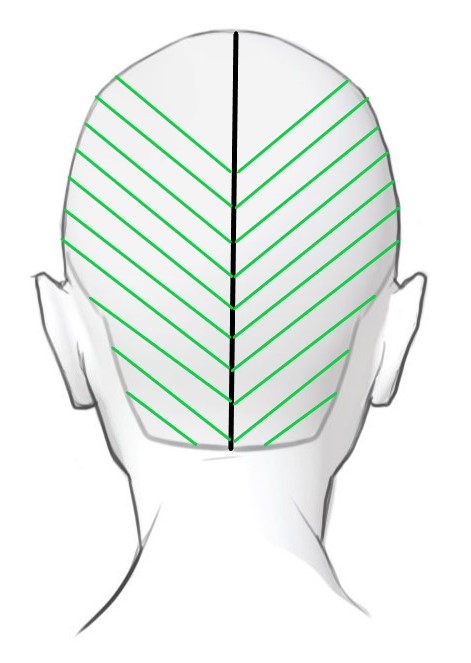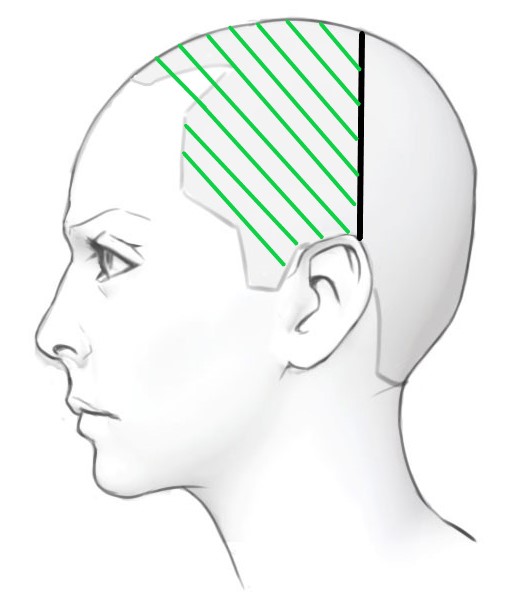Chapter 5 – Foiling Placement and Technique
5.4 Toning Techniques
A shadow root and drop root are toning techniques that are especially useful when the client likes the look of highlights but wants them to look more natural with less upkeep as they grow out.
Shadow Root
A shadow root, also known as a “root tap,” is a toning technique in which fresh highlights are toned with two different levels of toner, with a darker tone applied within zone 1 and the lighter tone applied to the rest of the hair. Generally, the two toners will vary by 1–2 levels in order to mimic a natural shadow at the regrowth.
Example:
Natural level 6, client is lifted to a level 9.
- Level 7 formula: Applied to first ¾ inch–1 inch at regrowth.
- Level 9 formula: Applied to remainder of hair.
On freshly highlighted hair, the level 7 serves to deepen the highlights at the regrowth enough to blend with the natural level, while allowing the highlights to show through and appear freshly done.
You can imagine that this also serves the purpose of softening the contrast as the highlights grow out between appointments. This is also a useful technique to make a global lightening application appear more natural.
Video: Shadow Root Application
Note: Video has no sound.
Drop Root
A drop root is a toning technique that is useful in the following circumstances:
- The client has been getting highlights to the root or a global lightening service and would like to change the look of their blonding to something that is a more lived-in technique, such as a balayage or ombré.
- The client would like highlights but would like a base level that is darker than their natural level to create more contrast.
Changing Technique
In the first scenario, when a client would like to change up their blonding technique from highlights or global blonde to a more lived-in look, a drop root can be done to soften and blend the existing blonde into the natural root colour. For this technique, it is optimal to match your formula as closely to their natural colour as possible.
Apply to the line of demarcation, and blend downwards with one or a combination of the following application methods:

To create the most seamless result, consider mixing two different formulas: One to match the regrowth, and one to apply to the mid-lengths and ends, such as a lighter level toner or a clear gloss. This allows you to blend the two formulas where they meet. Using the two formulas with a combination of techniques and angles of application will create the most blended result.
Drop Root Application Process
Tools Required
- Colour-safe gloves
- Colour cape
- Towels
- Hair clips
- Wide-tooth comb
- Colour bowl or bottle
- Weigh scale
- Tint brush – 2-inch or 4-inch standard or feather tipped
- Hair separator of your choice
Steps
- Section your client’s hair into 4 quadrants: section nose to nape and ear to ear.
- In the back, using ¼-inch subsections and diagonal back partings, work from the nape upwards. The diagonal partings will create a better blend, as you will not be creating any horizontal lines within the hair.

- Alternate application methods, varying your angle of application as you work.
- Separate your subsections, if you choose, with the hair separator of your choice, such as meche or foils.
- When you reach the crown, increase your angle of application to avoid creating a visible horizontal transition line.
- In the sides, continue working from the bottom up in diagonal back subsections. Continue to vary your angle of application, while using primarily ½-V placements to maintain lightness around the face.

- Separate your subsections, if you choose, with the hair separator of your choice.
- When you reach the top of the section, once again increase your angle of application to avoid creating a visible horizontal transition line.
- Process and rinse according to manufacturers guidelines.
Note: Video has no sound.
Darkening the Base
In the second scenario, in which the client would like to deepen their natural level while maintaining the look of highlights to the root, after applying the foils, you would mix and apply the drop root formula in between the foils, varying your methods of application as above. This leaves the highlights bright and fresh to the root but allows you to deepen the natural level by 1–3 levels.
When darkening the natural level, it’s important to inform your client of the maintenance involved. If using a permanent or demi-permanent, they will need to keep up with their root retouches as well as their highlights. Using a semi-permanent allows the colour to fade off gradually, allowing for a more subtle grow out with less maintenance.
Media Attributions
- All images in this chapter are by A. Magtiza and are under a CC BY 4.0 Licence.
- “Shadow Root Application” video by A. Magtiza is under a CC BY 4.0 Licence.
- “Drop Root Application” video by A. Magtiza is under a CC BY 4.0 Licence.
The application of colour over pre-lightened hair.
The first ½-inch to ¾-inches of hair growth.
The darkness or lightness of colour in relationship to other colours.
The line where the natural regrowth meets the previously coloured hair.

